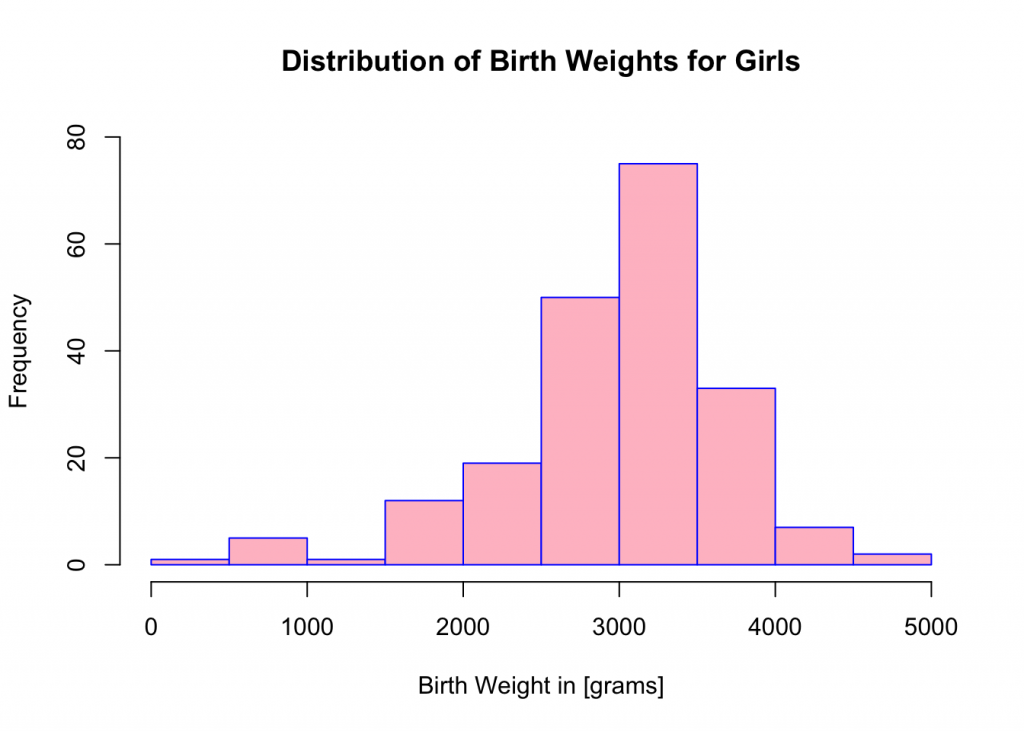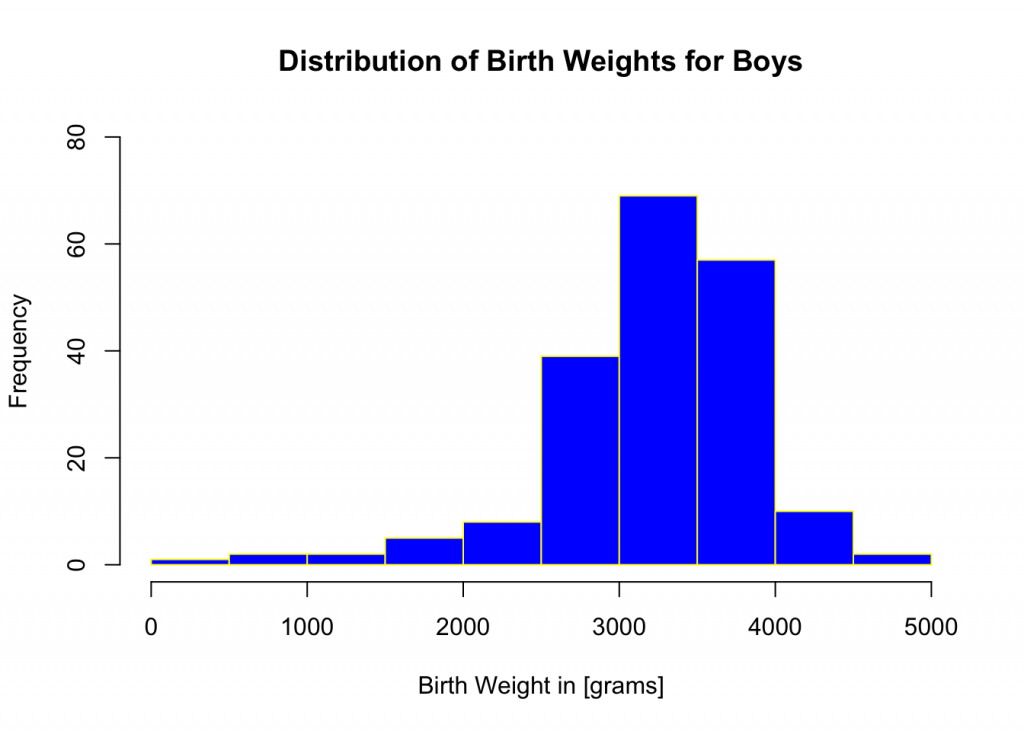Tutorial/Extra Credit Assignment
How to partition Births Data Set1 by gender?
How to create a histogram of Birth Weight Data Set for each gender?
Upload data set by using the following syntax:
BirthsD <-read.csv(file.choose(),header =TRUE)
attach(BirthsD)
head(BirthsD,3)## FACILITY INSURANCE GENDER..1.M.
## 1 Albany Medical Center Hospital Insurance Company 0
## 2 Albany Medical Center Hospital Blue Cross 1
## 3 Albany Medical Center Hospital Blue Cross 0
## LENGTH.OF.STAY ADMITTED DISCHARGED BIRTH.WEIGHT TOTAL.CHARGES
## 1 2 FRI SUN 3500 13985.7
## 2 2 FRI SUN 3900 3632.5
## 3 36 WED THU 800 359091.0Select all rows from the BirthsD data set that pertain to girls’ births and include all variables, (columns).
Start by naming this subset girlD, (girls data).
girlD <-BirthsD[GENDER..1.M. == "0",]
attach(girlD)## The following objects are masked from BirthsD:
##
## ADMITTED, BIRTH.WEIGHT, DISCHARGED, FACILITY, GENDER..1.M.,
## INSURANCE, LENGTH.OF.STAY, TOTAL.CHARGEShead(girlD)## FACILITY INSURANCE GENDER..1.M.
## 1 Albany Medical Center Hospital Insurance Company 0
## 3 Albany Medical Center Hospital Blue Cross 0
## 6 Albany Medical Center Hospital Blue Cross 0
## 7 Albany Medical Center Hospital Medicaid 0
## 9 Albany Medical Center Hospital Insurance Company 0
## 13 Albany Medical Center Hospital Insurance Company 0
## LENGTH.OF.STAY ADMITTED DISCHARGED BIRTH.WEIGHT TOTAL.CHARGES
## 1 2 FRI SUN 3500 13985.7
## 3 36 WED THU 800 359091.0
## 6 4 FRI TUE 2400 6406.0
## 7 3 TUE FRI 4200 4778.0
## 9 2 SAT MON 3100 3860.0
## 13 4 SUN THU 2000 6986.9summary(BIRTH.WEIGHT)## Min. 1st Qu. Median Mean 3rd Qu. Max.
## 300 2700 3100 3037 3500 4700Create a frequency table for Girls’ birth weights.
breaks <-seq(0,5000,by=500)
BIRTH.WEIGHT.cut <-cut(BIRTH.WEIGHT,breaks)
BIRTH.WEIGHT.freq <-table(BIRTH.WEIGHT.cut)
frequency.table <-transform(BIRTH.WEIGHT.freq)
frequency.table## BIRTH.WEIGHT.cut Freq
## 1 (0,500] 1
## 2 (500,1e+03] 5
## 3 (1e+03,1.5e+03] 1
## 4 (1.5e+03,2e+03] 12
## 5 (2e+03,2.5e+03] 19
## 6 (2.5e+03,3e+03] 50
## 7 (3e+03,3.5e+03] 75
## 8 (3.5e+03,4e+03] 33
## 9 (4e+03,4.5e+03] 7
## 10 (4.5e+03,5e+03] 2Create a histogram of birth weights for girls’ data subset using breaks and hist command.
breaks<-seq(0,5000,by=500)
hist(BIRTH.WEIGHT, xlab = "Birth Weight in [grams]", ylab="Frequency",ylim=c(0,80),main="Distribution of Birth Weights for Girls", col="pink",border="blue")
detach(girlD)Now: Select all rows from BirthsD data set that pertain to boys’ births and include all variables, (columns).
Start by naming this subset boyD, (boys’ data).
boyD <-BirthsD[GENDER..1.M. == "1", ]
attach(boyD)## The following objects are masked from BirthsD:
##
## ADMITTED, BIRTH.WEIGHT, DISCHARGED, FACILITY, GENDER..1.M.,
## INSURANCE, LENGTH.OF.STAY, TOTAL.CHARGEShead(boyD,3)## FACILITY INSURANCE GENDER..1.M.
## 2 Albany Medical Center Hospital Blue Cross 1
## 4 Albany Medical Center Hospital Insurance Company 1
## 5 Albany Medical Center Hospital Insurance Company 1
## LENGTH.OF.STAY ADMITTED DISCHARGED BIRTH.WEIGHT TOTAL.CHARGES
## 2 2 FRI SUN 3900 3632.5
## 4 5 MON SAT 2800 8536.5
## 5 2 FRI SUN 3700 3632.5summary(BIRTH.WEIGHT)## Min. 1st Qu. Median Mean 3rd Qu. Max.
## 300 2900 3400 3273 3650 4900Create a frequency table for Boys’ birth weights.
BIRTH.WEIGHT.cut <-cut(BIRTH.WEIGHT,breaks)
BIRTH.WEIGHT.freq <-table(BIRTH.WEIGHT.cut)
transform(BIRTH.WEIGHT.freq)## BIRTH.WEIGHT.cut Freq
## 1 (0,500] 1
## 2 (500,1e+03] 2
## 3 (1e+03,1.5e+03] 2
## 4 (1.5e+03,2e+03] 5
## 5 (2e+03,2.5e+03] 8
## 6 (2.5e+03,3e+03] 39
## 7 (3e+03,3.5e+03] 69
## 8 (3.5e+03,4e+03] 57
## 9 (4e+03,4.5e+03] 10
## 10 (4.5e+03,5e+03] 2Create a histogram of birth weights for boys data subset using breaks and hist command.
breaks<-seq(0,5000,by=500)
hist(BIRTH.WEIGHT, xlab = "Birth Weight in [grams]", ylab="Frequency",ylim=c(0,80),main="Distribution of Birth Weights for Boys", col="blue",border="yellow")
detach(boyD)Extra Credit Assignment
1. Use parts of the above syntax and create two box-and-whisker plots, (one for each gender), describe variability in each subset, and compare variability between genders.
2. Write a report using any word-processing program. Use full and complete sentences; remember to include numerical and graphical summaries in your report. In addition, attach R printout with input/output.
- Data Set 4: extracted from M. F Triola, Essentials of Statistics Sixth Edition, Pearson↩
Recent Comments